Chapter 7. Memory
Memory Models and Systems
Amelia Liangzi Shi
Approximate reading time: 23 minutes
Learning Objectives
By the end of this section, you will be able to:
- Describe the steps to the information-processing model of memory
- Describe the Atkinson-Shiffrin model of memory
- Explain how the Baddeley and Hitch (1974) working-memory model expands the concept of short-term memory
- Explain how maintenance rehearsal and elaborative rehearsal can improve your studying
Memory is an information processing system; therefore, we often compare it to a computer (Figure ME.2). Memory is the set of processes used to encode, store, and retrieve information over different periods of time.
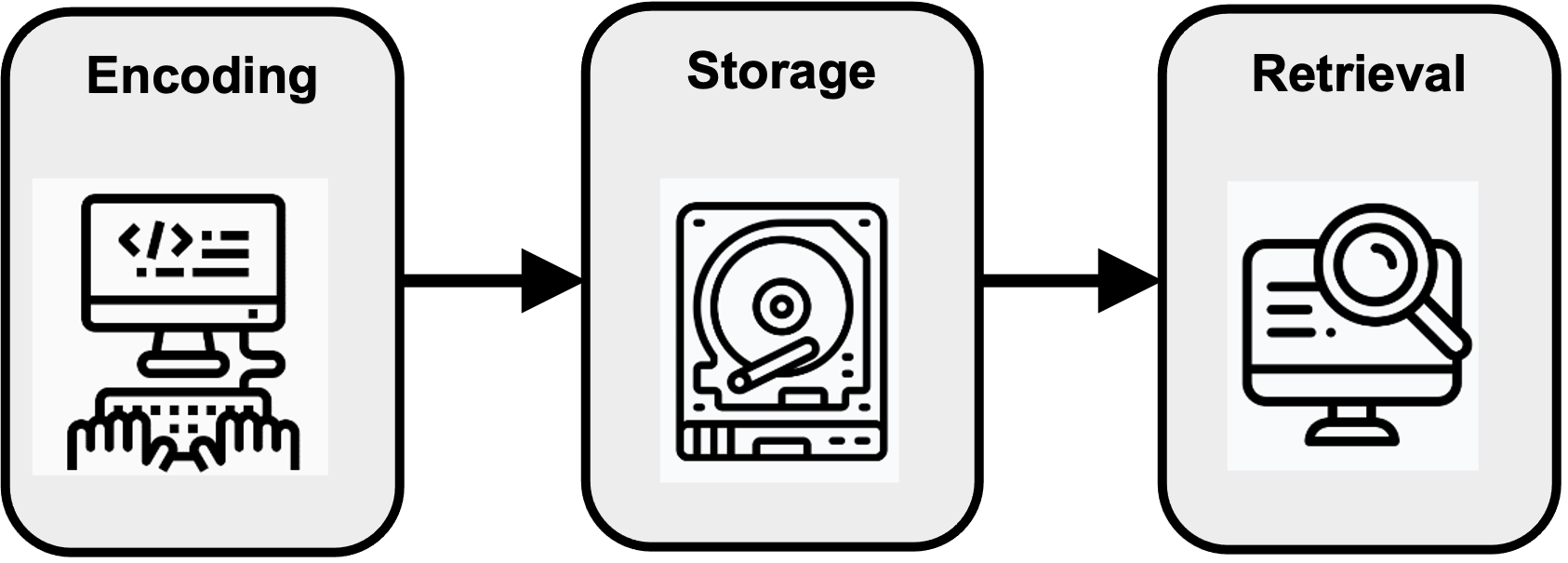
Encoding
We get information into our brains through a process called encoding. Encoding is the input of information into the memory system. Once we receive sensory information from the environment, our brains label or code it. We organise the information with other similar information and connect new concepts to existing concepts. Encoding information occurs through automatic processing and effortful processing.
If someone asks you what you ate for lunch today, more than likely you could recall this information quite easily. This is known as automatic processing. Automatic processing is usually done without any conscious awareness, like the encoding of details like time, space, frequency, and the source of information. On the other hand, studying the material for a test requires a lot of work and attention on your part. This is known as effortful processing.

Visual encoding is the encoding of images, and verbal encoding is the encoding of sounds, words in particular. To see how visual encoding works, read over this list of words: car, level, dog, truth, book, value. If you were asked later to recall the words from this list, which ones do you think you would most likely remember? You would probably have an easier time recalling the words car, dog, and book, and a more difficult time recalling the words level, truth, and value. Why is this? Because you can recall images (mental pictures) more easily than words alone. When you read the words car, dog, and book you created images of these things in your mind. These are concrete, high-imagery words. On the other hand, abstract words like level, truth, and value are low-imagery words. High-imagery words are encoded both visually and verbally (Paivio, 1991), thus building a stronger memory.
Words that had been encoded semantically were better remembered than those encoded visually or phonemically. Semantic encoding involves a deeper level of processing than the shallower visual or verbal encoding. In Craik and Tulving’s (1975) classic study, participants were shown words and asked questions that required superficial structural processing of a word (e.g., is the word, TABLE, in capital letters?), somewhat deep phonemic processing (e.g., does the word, CRATE, rhyme with WEIGHT?, or deep semantic processing (e.g., would the word, FRIEND, fit the sentence: He met a ____ in the street?). Deep processing increased later recognition of the words in a long list.
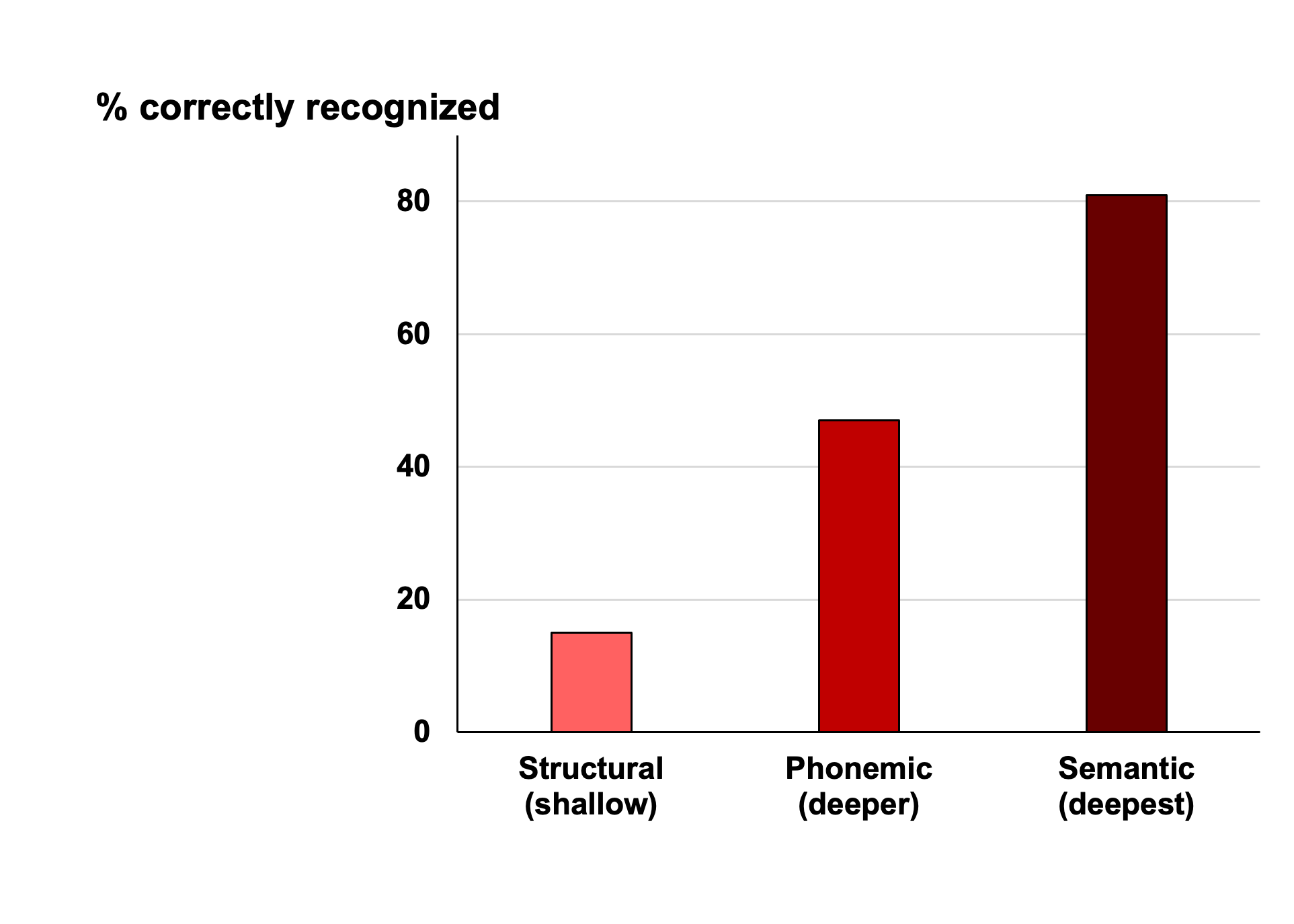
Craik and Tulving (1975) concluded that we process verbal information best through semantic encoding, especially if we apply what is called the self-reference effect. The self-reference effect is the tendency for an individual to have better memory for information that relates to oneself in comparison to material that has less personal relevance (Rogers et al., 1977). Could semantic encoding be beneficial to you as you attempt to memorise the concepts in this chapter?
Storage
One way of understanding memory is to think about it in terms of storage. The model of memory that has dominated this field for the last 50 years is the three-store memory model (Atkinson & Shiffrin, 1968). The Atkinson-Shiffrin model of memory, also called the three-store model, describes the active process of how information is encoded and retained. According to this model, information begins in sensory memory, moves to short-term memory, and eventually moves to long-term memory. However, not all information makes it through all three stages; most of it is forgotten. Whether the information moves from shorter-duration memory into longer-duration memory, or whether it is lost from memory entirely, depends on how the information is attended to and rehearsed.
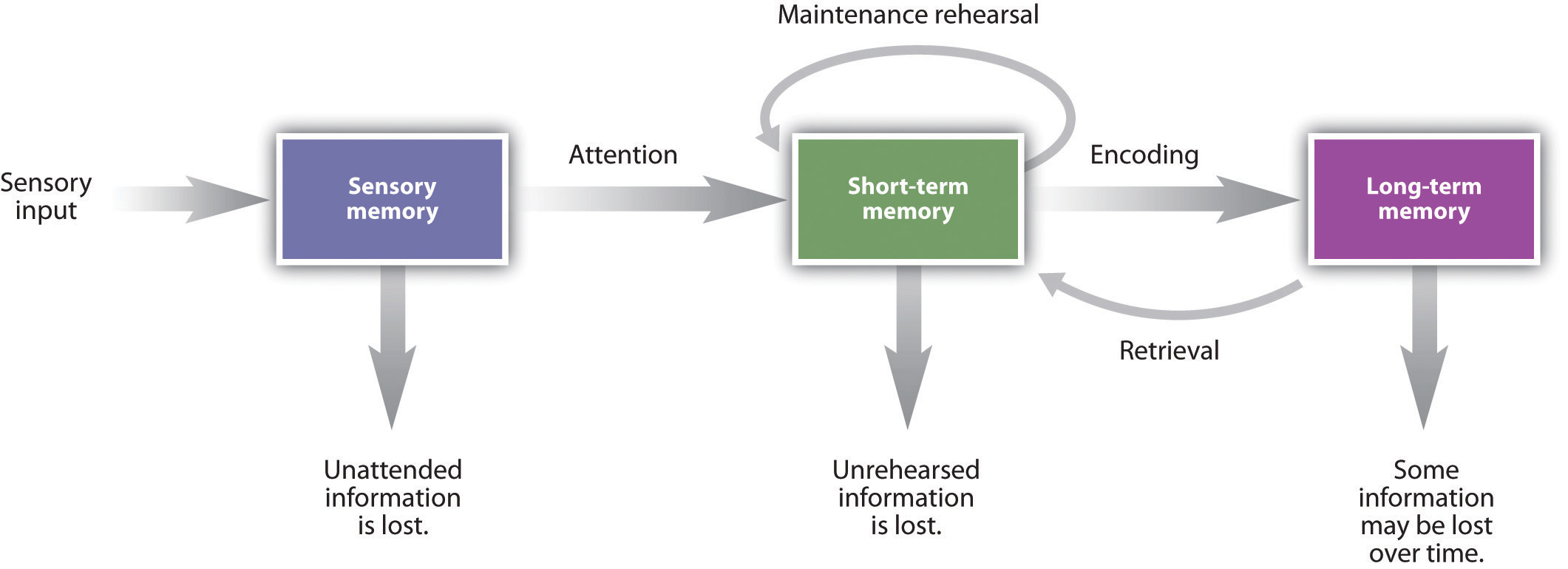
Sensory memory (or sensory register) refers to the brief storage of sensory information. Sensory memory is a memory buffer that lasts only very briefly. Unless it is attended to and passed on for more processing, it is forgotten. The purpose of sensory memory is to give the brain some time to process the incoming sensations and perceptions. Visual sensory memory is known as iconic memory. The duration of iconic memory was found to be 250 milliseconds (Sperling, 1960). In other words, people can hold visual information in their sensory memory for only about 1/4th of a second. Auditory sensory memory is known as echoic memory. Iconic memories decay very rapidly. In contrast, echoic memories can last as long as four seconds (Cowan et al., 1990). Echoic memory allows you to remember the words that you said at the beginning of a long sentence when you get to the end of it, and to take notes on your psychology professor’s most recent statement even after they have finished saying it.
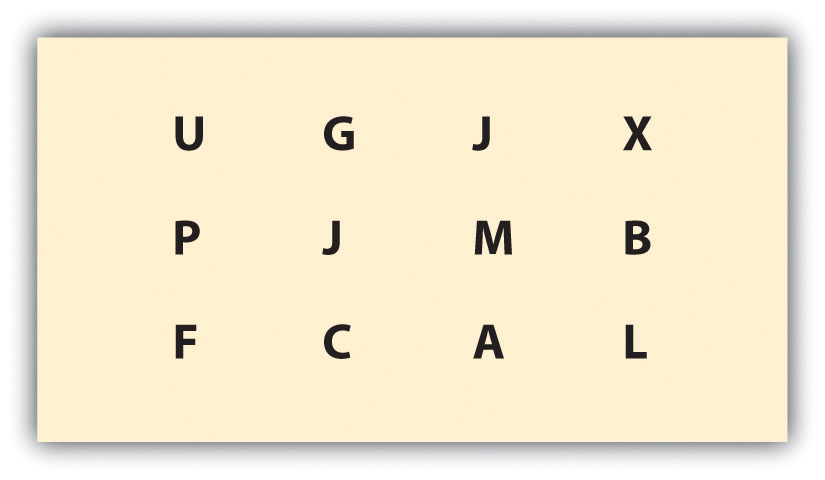
Most of the information that gets into sensory memory is forgotten. We only process things that we pay attention to into our short-term memory. Short-term memory (STM) is the theoretical place where small amounts of information can be temporarily kept for more than a few seconds but usually for less than one minute (Baddeley et al., 1990; Peterson & Peterson, 1959). Information in short-term memory is not stored permanently, but it becomes available for us to process. The processes that we use to make sense of, modify, interpret, and store information in STM are known as working memory.Atkinson and Shiffrin’s (1968) model is not the only model of memory. Baddeley and Hitch (1974) proposed a working memory model. In their model, short-term memory has different forms. Storing memories in short-term memory is like opening different files on a computer and adding information. The type of short-term memory (or computer file) depends on the type of information received. There are memories in visual-spatial form, as well as memories of spoken or written material, and they are stored in three short-term systems: a visuospatial sketchpad, an episodic buffer (Baddeley, 2000), and a phonological loop. According to Baddeley and Hitch (1974), a central executive part of memory supervises or controls the flow of information to and from the three short-term systems, and the central executive is responsible for moving information into long-term memory.
Watch this video: Tricky Topics: Atkinson-Shiffrin Model (5 minutes)
“Tricky Topics: Atkinson-Shiffrin Model” video by FirstYearPsych Dalhousie is licensed under the Standard YouTube licence.
Here is the Tricky Topics: Atkinson-Shiffrin Model transcript.
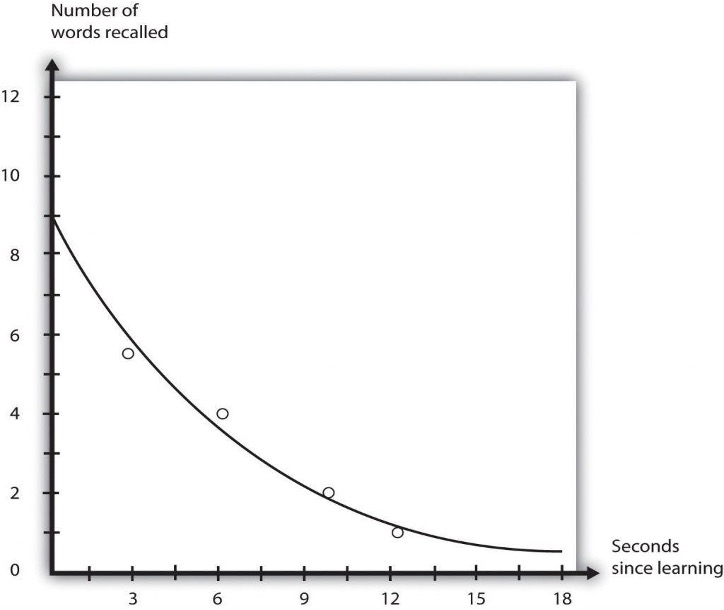
Watch this video: Tricky Topics: Baddeley & Hitch Working Memory Model (3.5 minutes)
“Tricky Topics: Baddeley & Hitch Working Memory Model” video by FirstYearPsych Dalhousie is licensed under the Standard YouTube licence.
Here is the Tricky Topics: Baddeley & Hitch Working Memory Model transcript.
Short-term memory is limited in both how long and how much information it can hold. One way to prevent the decay of information from short-term memory is to use working memory to rehearse it. Maintenance rehearsal is the process of repeating information mentally or aloud with the goal of keeping it in memory. We engage in maintenance rehearsal to keep something that we want to remember (e.g., a person’s name, email address, or phone number) in mind long enough to write it down, use it, or potentially transfer it to long-term memory (LTM).
If we continue to rehearse information, it will stay in STM until we stop rehearsing it. But there is also a capacity limit to STM. Try reading each of the following rows of numbers, one row at a time, at a rate of about one number each second. Then, when you have finished each row, close your eyes and write down as many of the numbers as you can remember.
019
3586
10295
861059
1029384
75674834
657874104
6550423897
If you are like the average person, you will have found that on this digit span test of short-term memory, you did pretty well up to about the fourth line and then started having trouble. You likely missed some of the numbers in the last three rows and did pretty poorly on the last one.
The digit span of most adults is between five and nine digits, with an average of about seven. Miller (1956) referred to “seven plus or minus two” pieces of information as the magic number in short-term memory. Yet, if we can only hold a maximum of about nine digits in short-term memory, then how can we remember larger amounts of information than this? For instance, how can we ever remember a 10-digit phone number long enough to dial it?
According to Craik and Tulving’s (1975) findings, if we want to remember a piece of information, we should think about it more deeply and link it to other memories to make it more meaningful. This is called elaborative rehearsal. For instance, one way we are able to expand our short-term memory ability is chunking. Chunking is the process of organising information into smaller groupings (i.e., chunks), thereby increasing the number of items that can be held in short-term memory.
Try to remember this string of 12 letters:
You probably will not do that well because the number of letters is more than the magic number of seven. Now try again with this one:
Would it help if you knew that the material in this string could be chunked into four sets of three letters each? It likely would, because instead of remembering 12 letters, you would only have to remember the names of four television stations: CTV, CBC, TSN, and HBO. In this case, chunking changes the number of items you have to remember from 12 to only four.
You could also employ mnemonics like ROYGBIV, which is an anagram containing the letter of the first word of all colours in the visual spectrum, or CANOE, which is another anagram of first letters, but this time for the five personality factors in the “Big Five” model. For more examples, see McCabe’s (2011) article Integrating Mnemonics into Psychology Instruction. Students often rely on reading or highlighting the textbook to encode material into long term memory; however, this is a relatively poor strategy because it is passive, and it can “feel” like you have accomplished something when, really, the material has not been meaningfully encoded.
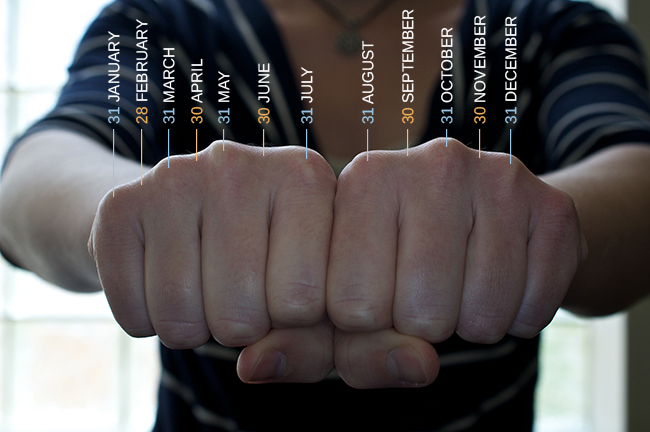
If information makes it past short-term memory, it may enter long-term memory (LTM). Information in LTM can be held for days, months, and years. The capacity of LTM is large. There is no known limit to what we can remember (Wang et al., 2003). Although we may forget at least some information after we learn it, other things will stay with us forever. In Section 10.2, we will discuss different types of long-term memory.
Retrieval
Even when information has been adequately encoded and stored, it does not do us any good if we cannot retrieve it. Retrieval refers to the process of reactivating information that has been stored in memory. There are two ways you can retrieve information out of your long-term memory storage system: recall and recognition. Recall is what we most often think about when we talk about memory retrieval: it means you can access information without cues. For example, you would use recall for an essay test. Recognition happens when you identify information that you have previously learned after encountering it again. It involves a process of comparison. When you take a multiple-choice test, you are relying on recognition to help you choose the correct answer.
You may find multiple-choice questions are easier than essay questions because the former typically provide more retrieval cues. A retrieval cue is a stimulus that activates information stored in long-term memory. The best retrieval cues come from associations we form at the time we encode a memory. The encoding specificity principle helps us understand how cues specific to an event or person will most effectively trigger that memory. It predicts that we are more likely to be able to retrieve items from memory when conditions at retrieval are similar to the conditions under which we encoded them.
Context-dependent memory refers to an increase in retrieval when the external situation in which information is learned matches the situation in which it is remembered. Researchers tested the memory of scuba divers to learn and retrieve information in different contexts and found strong evidence for context-dependent memory (Godden & Baddeley, 1975). They asked the divers to learn a list of words either when they were on land or when they were underwater. Then, they tested the divers on their memory, either in the same or the opposite situation. The divers’ memory was better when they were tested in the same context in which they had learned the words than when they were tested in the other context. You can see that context-dependent memory might also be important in improving your memory. For instance, you might want to try to study for an exam in an environment that is similar to the one in which you are going to take the exam.
| During Learning | During Recall | Average percent of words recalled |
|---|---|---|
| Underwater | Underwater | 32% |
| Underwater | On land | 23% |
| On land | On land | 38% |
| On land | Underwater | 24% |
Table adapted from Jern (2020).
Whereas context-dependent memory refers to a match in the external situation between learning and remembering, state-dependent memory refers to superior retrieval of memories when the individual is in the same internal or psychological state as during encoding. Research discovered that fewer mistakes in memory occurred when participants were under the influence of alcohol during both study and test sessions compared to when they were only under the influence during the study session (Goodwin et al., 1969). However, it’s important to remember that studying and testing without being intoxicated is always a better choice! Research with humans finds that bilinguals remember better when tested in the same language in which they learned the material (Marian & Neisser, 2000). In particular, research on mood-congruent memory indicates that it is easier to recall unpleasant memories than pleasant ones when we are sad, and easier to recall pleasant memories than unpleasant ones when we are happy (Eich & Metcalfe, 1989).
Learning sequence also predicts retrieval. If we show people a list of words one by one, like on flashcards, and then ask them to remember the words, they can remember more words from the beginning and the end of the list compared to the words in the middle of the list. This pattern, known as the serial position curve, is caused by two retrieval phenomena: primacy effect and recency effect. The primacy effect refers to a tendency to better remember items presented early in a list. The recency effect refers to the tendency to better remember items presented at the end of the list.
There are a number of explanations for primacy and recency effects, but one of them is in terms of the effects of rehearsal on short-term and long-term memory (Baddeley et al., 2009). Because we can keep the last words that we learned in the presented list in short-term memory by rehearsing them before the memory test begins, they are relatively easily remembered. So, the recency effect can be explained in terms of maintenance rehearsal in short-term memory. As well, the primacy effect may also be due to rehearsal — when we hear the first word in the list we start to rehearse it, making it more likely that it will be moved from short-term to long-term memory.
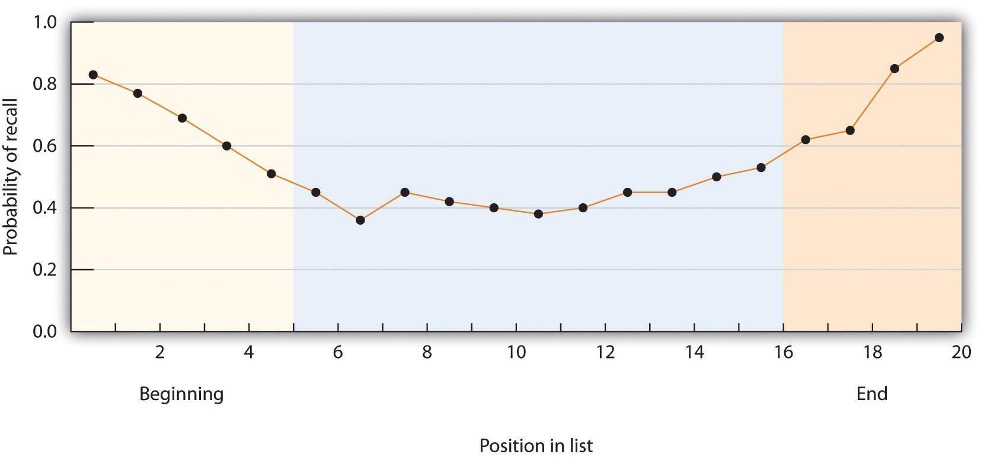
The ultimate strategy for enhancing long-term memory is likely practice retrieval, which is supported by the testing effect (Roediger & Karpicke, 2006). After the initial learning phase, participants in the “restudy” condition learned the previous materials again, whereas those in the “testing” condition took a quiz on the learned materials. Although “restudy” and “testing” yielded similar performances on the recall tests immediately following the restudy/testing phase, “testing” led to much better recall than “restudy” on the final exams with a two-day or one-week delay. Likewise, with more practice quizzes, participants performed better in the delayed recall tests (but not in the immediate recall tests). Practice retrieval is considered to be a better strategy than restudying the materials over and over again, because in the real world, the exams almost always come with a long delay.
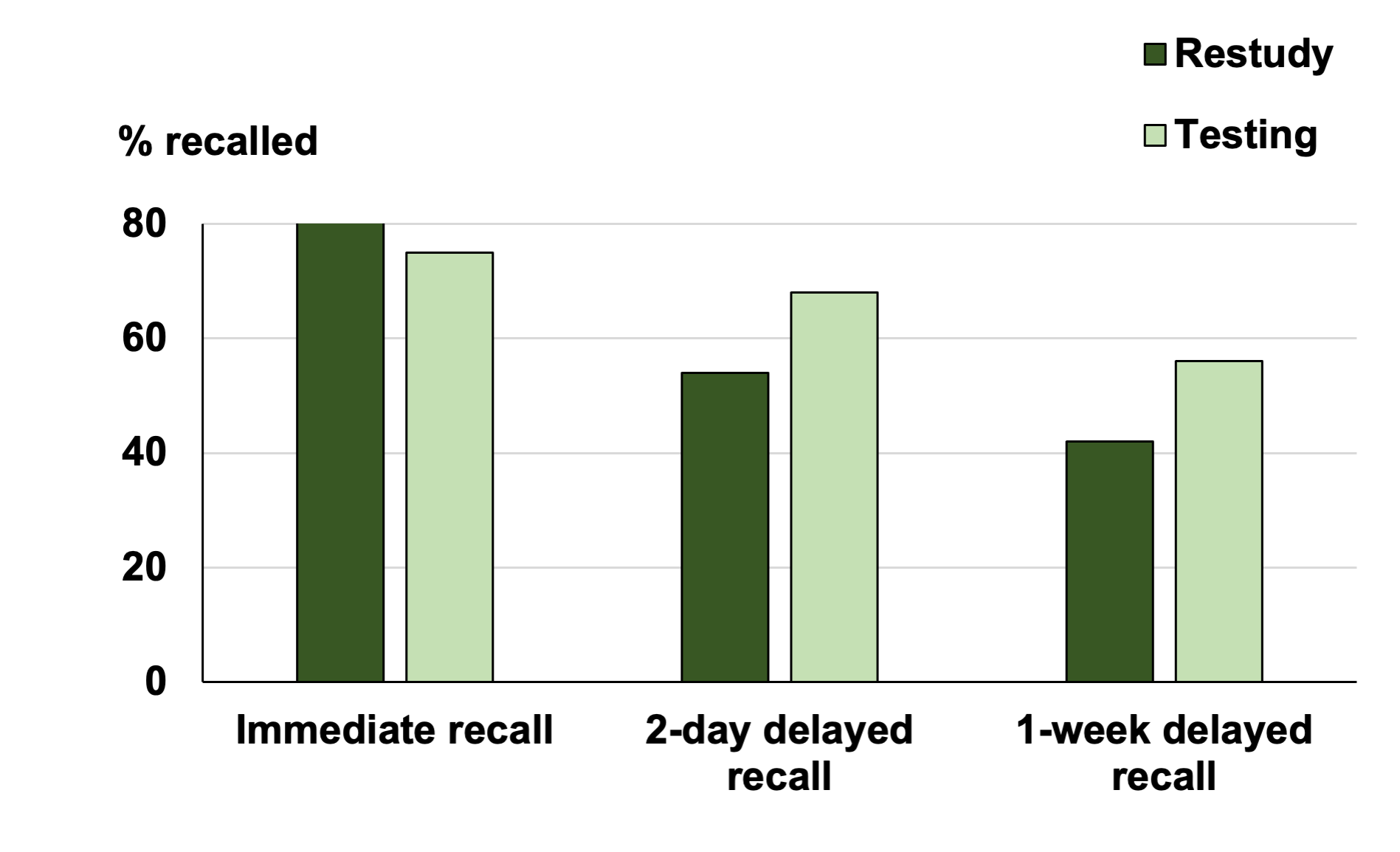
To obtain the best outcome of practice testing, you may want to consider the spacing effect – learning is better if it is spread out over periods of time than if it occurs closer together or at the same time. This means that you will learn more if you study continually throughout the semester — a little bit every day is best — than if you wait to cram at the last minute before your exam. Another good strategy is to study and wait as long as you can before you forget the material. Then, review the information and again wait as long as you can before you forget it. This will probably be a longer period of time than the first time. Repeat, and repeat again. The spacing effect is usually considered in terms of the difference between distributed practice (i.e., practice that is spread out over time) and massed practice (i.e., practice that comes in one block), with the former approach producing better memory.
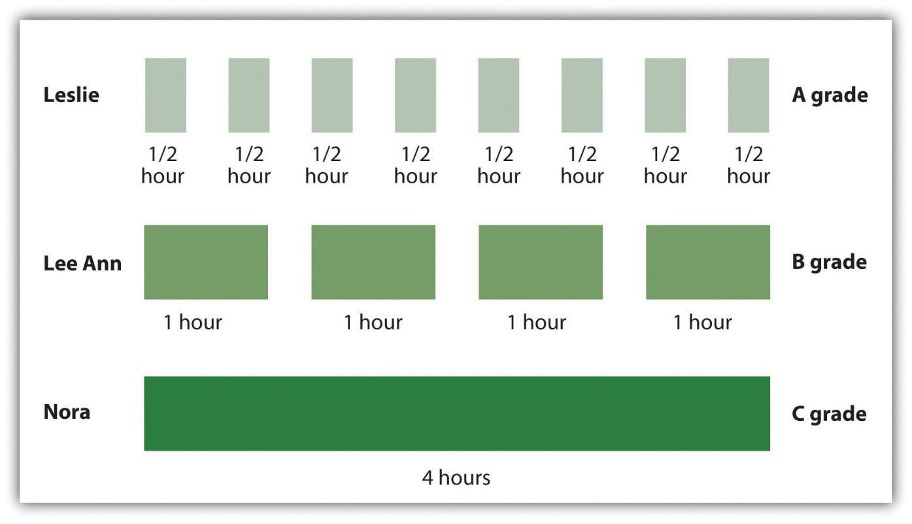
Our memory works like a smart information system, doing three main jobs: putting info in (encoding), keeping it for a while (storage), and bringing it back out when we need it (retrieval). In the next part, we’ll explore the different types of long-term memory to understand how our brain stores various kinds of information.
Image Attributions
Figure ME.2. Encoding, Storage and Retrieval is licensed under a CC BY-NC-SA license.
Figure ME.3. Photo by JESHOOTS.com is licensed under the Pexels license.
Figure ME.4. Craik and Tulving’s (1975) Experiment 2 is licensed under a CC BY-NC-SA license.
Figure ME.5. Figure 10.2 as found in Psychology – 1st Canadian Edition is licensed under a CC BY-NC-SA License.
Figure ME.6. Figure 10.3 as found in Psychology – 1st Canadian Edition is licensed under a CC BY-NC-SA License.
Figure ME.7. Figure 10.4 as found in Psychology – 1st Canadian Edition is licensed under a CC BY-NC-SA License.
Figure ME.8. Figure 8.18 as found in Psychology 2e by OpenStax is licensed under a CC BY 4.0 License and contains modifications of work by Cory Zanker.
Figure ME.9. Serial position curve is licensed under a CC BY-NC-SA License.
Figure ME.10. Testing Effect is licensed under a CC BY-NC-SA License.
Figure ME.11. The spacing effect is licensed under a CC BY-NC-SA License.
To calculate this time, we used a reading speed of 150 words per minute and then added extra time to account for images and videos. This is just to give you a rough idea of the length of the chapter section. How long it will take you to engage with this chapter will vary greatly depending on all sorts of things (the complexity of the content, your ability to focus, etc).

